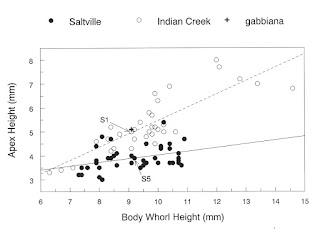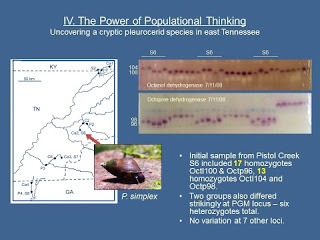Editor’s Note – This essay was subsequently published as:
Dillon, R.T., Jr. (2019d) Freshwater Gastropods Take To The Air, 1991. Pp 95 - 100 in The Freshwater Gastropods of North America Volume 4,
Essays on Ecology and Biogeography.
FWGNA Press, Charleston.
Thirty years ago, when I signed my contract with Cambridge
University Press to deliver the book that ultimately became The Ecology of
Freshwater Molluscs [1] I had a larger project in mind. The original title of the book was to have
been, The Evolutionary Ecology of Freshwater Mollusca, and I planned to cover
population genetics all the way up to speciation, as well as life history,
competition, predation, communities, and the more traditionally ecological
topics. That was too much.
But before I realized that I had bitten off more than I
could chew, I spent the summer of 1991 working on a chapter about freshwater
mollusk gene flow. It included
subsections on straight-ahead crawling, drift, and “phoresy” under which I
lumped all the cases where mollusks are carried passively by anything,
including fish carrying the glochidia of freshwater mussels. I even covered human-mediated invasions in
that chapter, or at least tried. Way,
way too much!
I never submitted my gene flow chapter for publication. But I rediscovered a hard copy again as I was
moving out of my old office this past August, together with a bunch of raw data
and tables and figures, and analyses on tractor-feed printer paper, and it
re-awakened a dormant interest [2], and gave it a fresh slant. How much has science advanced in 25
years? The quick answer is that in some
areas, progress has been Yuuuuge! But in
other areas, not so much.
 So for the next couple months we’ll focus on dispersal in freshwater
gastropods. Any study of which, in 1991
or in the present day, might well begin with the charming 1965 “presidential
address” offered by W. J. Rees, “The aerial dispersal of Mollusca” [3]. Rees accumulated dozens of published
references, notes, stories and anecdotes about both bivalves and gastropods,
both terrestrial and aquatic, both pinched onto the feet and riding upon the
shoulders of birds, bugs and bats, and even occasionally sucked up in cyclones
and spat out on the bowlers of unsuspecting Englishmen.
So for the next couple months we’ll focus on dispersal in freshwater
gastropods. Any study of which, in 1991
or in the present day, might well begin with the charming 1965 “presidential
address” offered by W. J. Rees, “The aerial dispersal of Mollusca” [3]. Rees accumulated dozens of published
references, notes, stories and anecdotes about both bivalves and gastropods,
both terrestrial and aquatic, both pinched onto the feet and riding upon the
shoulders of birds, bugs and bats, and even occasionally sucked up in cyclones
and spat out on the bowlers of unsuspecting Englishmen.
Rees collected 10 reports of freshwater limpets on aquatic
insects, and I found two additional cases published between 1965 and 1991 – van
Regteren Altena (1968) reporting 6 ancylids on the elytra of an aquatic beetle
in Surinam, and Rosewater (1970) reporting 2 Laevapex taken from the elytra of
a dytiscid beetle captured in a Florida light trap [4]. Does that total surprise you as much as it
surprises me? Even I, who have devoted my entire professional life to malacology, think of freshwater limpets as among the most
obscure of all God’s creatures. They’re
just tiny little brown bumps, for Heaven sake!
Would you have guessed 12 published reports of freshwater limpets on flying
water bugs? That’s probably more than
the total number of papers published on all other aspects of ancylid biology in
North America combined.
The overland dispersal of non-limpet families of freshwater gastropods
seems to be significantly less common.
Rees conveyed the report of a single Australian worker, who on different
occasions found 6 species of snails on the feet of ducks. I caught one more – the report of Roscoe (1955)
of juvenile Physa, Lymnaea, and Helisoma on the feathers of a white ibis
collected in Utah [5].
The review of Rees was followed by a couple really cute
experimental papers published between 1965 and 1991 – those of Boag [6] on floating
feathers and Malone [7] on severed killdeer feet.
Malone simply shot a killdeer, mounted its legs on a pair of
props, and moved them through shallow water where the birds had been observed
feeding. He inspected the legs
frequently, never allowing them to remain stationary for more than three
minutes. Two resident snails, Lymnaea humilis (“obrussa”) and Promenetus exacuous [8] often attached passively, drawn
by the surface film or dislodged from vegetation as the feet moved
through. Although adult Lymnaea clung no
more than five minutes if the feet moved, Promenetus and juvenile Lymnaea remained
attached indefinitely. All snails fell
off when re-immersed in water. Malone
reported that L. humilis could survive 2 – 14 hours out of water, and Promenetus
5 – 14 hours, although admittedly not in conditions designed to duplicate
flight.
Malone also reported that mature Lymnaea attached to the feathers
of a (presumably footless) killdeer body left floating in shallow water for
only three minutes. Continuing along
these lines, Boag [6] reared populations of Lymnaea stagnalis, L. elodes, and
Helisoma trivolvis from eggs to age three months, periodically floating a
feather in each culture pail. Feathers
with adhering snails were removed and placed in an air jet simulating flight
speed for up to 15 minutes. He record
the sizes of the snails attached, their detachment rates, and their subsequent
viability. All of the (many) hundred
snails found attached to feathers were in the 1 – 3 mm size range. Although Boag did not monitor the size distributions
of the base populations, it seems certain that the volunteer aviators tended to
be significantly smaller, especially as the months of his experiment
advanced. The figure below shows his
results combined over the duration of the experiment for the population with
the largest data set, L. elodes.
Although riding on a feather must at best be only a rough
approximation of riding on a bird, it is safe to conclude that either
experience is quite rigorous. Factoring both
attachment and survivorship together, Boag’s data show that 56% of the L.
elodes would arrive viable after 1 minute of flight, 17% after 5 minutes, 16%
after 10 minutes, and only 4% after 15 minutes.
Figures were comparable for L. stagnalis and suggested an even lower
probability of successful colonization for H. trivolvis.
 |
| Juvenile L. elodes on feathers exposed to simulated flight [6] |
Three points emerge from the consideration of Malone’s data together
with those of Boag. First, it is clear
that the attachment of snails to birds is the easy part, although perhaps only
the smallest are likely to hold on. And survivorship
of these (typically small) individuals riding on birds is probably nowhere near
the hours suggested by Malone, but more like minutes. But finally, since the absolute frequency at
which snails become attached to birds may be surprisingly high, even a 4%
survival rate may be sufficient to render aerial dispersal a significant factor
in initial colonization and subsequent gene flow among populations of
freshwater snails.
In 1991 I also reviewed a second set of experiments
published by Malone [9] assessing the likelihood of freshwater gastropod
dispersal via gut transport. It’s not
great. Malone fed caged ducks large
volumes of aquatic vegetation, to which were attached the adults, juveniles,
and egg masses of Physa and Helisoma.
Although he did not offer an estimate of the number of individual snails
ingested, one can indirectly infer that this was surely in the thousands. While no adults or juveniles were identified
in the feces, Malone recovered 9 viable Physa embryos. He also tried feeding about 500 – 1000 Physa
egg masses and 200 – 400 Helisoma egg masses to killdeer, collecting feces in
aerated water. A total of 17 viable embryos
were recovered.
Almost all of the material above was extracted from my 1991
chapter on dispersal. So what progress
have we made in studies on the aerial dispersal of freshwater gastropods since? A fair amount, actually. Tune in next month!
Notes
[1] Dillon, R. T. Jr.
(2000) The Ecology of Freshwater Molluscs. Cambridge University Press. 509 pp.
[2] This is the second essay I have posted on the subject of aerial dispersal in freshwater gastropods, the first coming way back in
November of 2005. I also invoked a gene
flow mechanism I termed the “sticky bird express” just this past April. See:
- Aerial Dispersal of Freshwater Gastropods [17Nov05]
- Mitochondrial Superheterogeneity: What it means. [6Apr16]
[4] van Regteren Altena, C. O. (1968)
Transport of Ancylidae (Gastropoda) by a water beetle in Surinam. Basteria 32:1. Rosewater, J. (1970) Another record of insect dispersal of
an ancylid snail. Nautilus 83: 144-145.
[5] Roscoe , E. J. (1955)
Aquatic snails found attached to feathers of white-faced glossy
ibis. Wilson Bulletin 67: 66.
[6] Boag, D. A. (1986) Dispersal in pond snails: Potential
role of waterfowl. Can. J. Zool. 64: 904-909.
[7] Malone, C. R. (1965) Killdeer (Charadrius vociferus) as
a means of dispersal for aquatic gastropods. Ecology 46: 551-552.
[8] I’m a bit skeptical of this identification. Perhaps Promenetus is significantly more
common in NW Montana, where Malone conducted his research, than anyplace I have
any personal observations. But my guess
would be Gyraulus parvus, not P. exacuous.




















